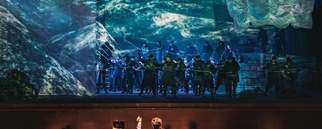|
Back
Senta Saves the Dutchman and the Opera Firenze
Teatro del Maggio Musicale Fiorentino
01/10/2019 - & January 13, 15*, 17, 2019
Richard Wagner: Der fliegende Holländer
Thomas Gazheli (Dutchman), Mikhail Petrenko (Daland), Marjorie Owens (Senta), Timothy Oliver (Steersman), Bernhard Berchtold*/Peter Tantsits (Erik), Annette Jahns (Mary)
Coro del Maggio Musicale Fiorentino, Lorenzo Fratini (chorus master), Coro Ars Lyrica, Pisa, Marco Bargagna (chorus master), Orchestra del Maggio Musicale Fiorentino, Fabio Luisi (conductor)
Paul Curran (stage director) Saverio Santoliquido (sets), Gabriella Ingram (costumes), David Martin Jacques (lights), Otto Driscoll (videography)

Maggio Musicale Fiorentino’s production of Der fliegende Holländer opened with a well-conducted overture, with brisk tempi and mercifully no video or choreographed accompaniment. Wagner’s music is powerful enough to set the mood for this drama. Effective video was however successfully employed at the start of Act I to represent the agitated sea. Likewise, the Dutchman’s ship, reminiscent of the pirate ship in the recent Pirates of the Caribbean movies, was represented through an awe-inspiring video projection. The magical sliding of the Dutchman’s treasure on board the Norwegian ship was effective, and enhanced the fantastical element. In the final act, the zombie-like Dutchman’s crew were less convincing.
Mikhail Petrenko has a rich deep bass, appropriate for the role of Daland. However, his voice was not at its best in the opening scene. It improved as the opera progressed. The Russian singer’s German diction was approximate. It was nearly amusing to hear such a thick accent, reminiscent of earlier days. The tempi in his duet with the Dutchman at the end of Act I were too slow, possibly to accommodate Petrenko’s laboured diction. His portrayal of the greedy Norwegian skipper, too ready to sell his daughter for the Dutchman’s riches, was a caricature. This introduced an unintended element of comedy which at times compromised the drama.
Thomas Gazheli’s Dutchman was vocally imperfect but extremely moving. His timbre is a pleasant one, with exemplary diction, but his voice became hoarse by the end of the first act. Before the second act, it was announced that the bass-baritone was indisposed and that he was going through with the rest of the performance nonetheless. Gazheli’s acting was heart wrenching, accentuated by a slight limp and a shaking of one hand. This Dutchman, dressed in 17th century Dutch attire reminiscent of prosperous Dutch merchants in Rembrandt’s paintings, looked like a once proud and arrogant man. His “Die Frist ist um” conveyed the anti-hero’s anguish. His emphasis on certain phrases such “Nirgends ein Grab! Niemals der Tod! Dies der Verdammnis Schreckgebot” and “Vergebne Hoffnung! Furchtbar eitler Wahn!” were both effective and deeply moving.
Marjorie Owens, the star of the show, was incandescent as Senta. In her Act 2 ballad, one thoroughly believed this woman was haunted by the story of the doomed Dutchman. Her warm voice is rich and powerful, equally well-supported throughout the registers. Her high notes were secure and her diction exemplary. Phrases such as “Wem ich sie weih, schenk ich die eine; die Treue bis zum Tod” in the second act duet with the Dutchman, and again the opera’s final phrase “Preis deinen Engel und sein Gebot! Hier steh ich, treu dir bis zum Tod!” were poignant. Her movement on stage, slow at moments and stationary in others, was effective in setting the dramatic mood. At the end of Act 2’s Dutchman-Senta duet, her hand gestures to the Dutchman were more effective than any effusive embrace or passionate kiss. Her mastery of stage movement gave the role of Senta the allure of a Greek tragic heroine.
The three smaller roles, Erik, the Steersman and Mary were well interpreted. Bernhard Berchtold was a passionate Erik. His emphatic vocal and acting style contrasted well with Owens’ more reserved acting style. Timothy Oliver was a spirited Steersman, with stage presence to spare. His tenor voice is sweet, appropriate to his youth. Annette Jahns’ convincing portrayal of Mary as a forbidding but not unsympathetic school mistress or factory supervisor compensated for her vocal limitations. The chorus was well-rehearsed, especially in the famous “Steuermann! Lass die Wacht” Norwegian sailors’ Act 3 opening chorus, where the choreography evoked a virile atmosphere, rarely seen in our politically-correct times. The Spinning Chorus at the opening of Act II did not seem as well rehearsed, but the sets for that opening scene to Act 2 were inspired. They evoked communist-era Latvia or East Germany rather than Norway.
Fabio Luisi’s conducting was masterful during the overture and orchestral passages, but invariably the singers seemed under-rehearsed. The choice of having an intermission after the first act, instead of the now more common uninterrupted opera in its entirety, disrupted the drama, but it is perhaps necessary in Italy, where Wagner is not a typical favourite.
Ossama el Naggar
|